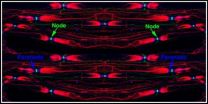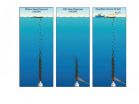(Press-News.org) Everybody who has been aboard a ship has heard the advice: if you feel unsteady, look at the horizon. For a study published in Psychological Science, a journal of the Association for Psychological Science, researchers measured how much people sway on land and at sea and found there's truth in that advice; people aboard a ship are steadier if they fix their eyes on the horizon.
Thomas A. Stoffregen of the University of Minnesota has been studying "body sway" for decades—how much people rock back and forth in different situations, and what this has to do with motion sickness. In just a normal situation, standing still, people move back and forth by about four centimeters every 12 to 15 seconds. Stoffregen and his coauthors, Anthony M. Mayo and Michael G. Wade, wanted to know how this changes when you're standing on a ship.
To study posture at sea, Stoffregen made contact with the U.S. consortium that runs scientific research ships. "I'm really an oddball for these folks, because they're studying oceanography, like hydrothermal vents. Here's this behavioral scientist, calling them up," he says. He boards a ship when it is travelling between different projects—for example, in this study, he rode on the research vessel Atlantis as it went between two points in the Gulf of California. "It had nothing to do with the fact that I like cruising near the tropics," he jokes. Since the ships are between scientific expeditions, he can sleep in one of the empty bunks normally reserved for ocean scientists, and crew members volunteer to take part in his study.
The study compared the same people standing on dry land—a dock in Guaymas, Mexico—and aboard the ship. In each experiment, the crew member stood comfortably on a force plate and focused on a target—either something about 16 inches in front of them, or a far-off point; a distant mountain when standing on land or the horizon when standing on the ship. On land, people were steadier when they looked at the close-up target and swayed more when they looked far away. On the ship, however, they were steadier when they looked at the horizon.
This is actually counterintuitive, Stoffregen says. When you're standing on a ship, you need to adjust to the ship's movement, or you'll fall over. So why would it help to look at the horizon and orient yourself to the Earth? He thinks it may help stabilize your body by helping you differentiate between sources of movement—the natural movement coming from your body and the movement caused by the ship.
Stoffregen thinks this motion of bodies may predict motion sickness. "It's the people who become wobbly who subsequently become motion sick," he says. He had originally hoped to study seasickness directly, but so far his subjects have all been seasoned crew members who are used to the ship's movement and don't get sick; his dream is to do his experiments aboard a ship full of undergraduate oceanography majors going to sea for the first time. "I'd give my right arm to get on one of those."
###
For more information about this study, please contact Thomas Stoffregen at tas@umn.edu.
The APS journal Psychological Science is the highest ranked empirical journal in psychology. For a copy of the article "Postural Effects of the Horizon on Land and at Sea" and access to other Psychological Science research findings, please contact Keri Chiodo at 202-293-9300 or kchiodo@psychologicalscience.org.
Centuries of sailors weren't wrong: Looking at the horizon stabilizes posture
2011-01-27
ELSE PRESS RELEASES FROM THIS DATE:
Low socioeconomic status increases depression risk in rheumatoid arthritis patients
2011-01-27
A recent study confirmed that low socioeconomic status (SES) is associated with higher risk of depressive symptoms in patients with rheumatoid arthritis (RA). Statistically significant differences in race, public versus tertiary-care hospital, disability and medications were found between depressed and non-depressed patients. Study findings are reported in the February issue of Arthritis Care & Research, a journal published by Wiley-Blackwell on behalf of the American College of Rheumatology (ACR).
Roughly 1.3 million Americans are affected by RA—a chronic autoimmune ...
Waterhemp rears its ugly head ... again
2011-01-27
Waterhemp has done it again. University of Illinois researchers just published an article in Pest Management Science confirming that waterhemp is the first weed to evolve resistance to HPPD-inhibiting herbicides.
"A fifth example of resistance in one weed species is overwhelming evidence that resistance to virtually any herbicide used extensively on this species is possible," said Aaron Hager, U of I Extension weed specialist.
Waterhemp is not a weed species that can be adequately managed with one or two different herbicides, Hager said. This troublesome weed requires ...
Agave fuels global excitement as a bioenergy crop
2011-01-27
Scientists found that in 14 independent studies, the yields of two Agave species greatly exceeded the yields of other biofuel feedstocks, such as corn, soybean, sorghum, and wheat. Additionally, even more productive Agave species that have not yet been evaluated exist.
According to bioenergy analyst, Sarah Davis, "We need bioenergy crops that have a low risk of unintended land use change. Biomass from Agave can be harvested as a co-product of tequila production without additional land demands. Also, abandoned Agave plantations in Mexico and Africa that previously supported ...
The undead may influence biodiversity, greenhouse gas emissions
2011-01-27
EAST LANSING, Mich. — It's commonly known, at least among microbiologists, that microbes have an additional option to living or dying — dormancy.
Dormant microbes are less like zombies and more like hibernating bears. What isn't known, however, is how large numbers of dormant microorganisms affect the natural environments when they act as microbial seed banks. In the current issue of Nature Reviews: Microbiology, Jay Lennon, Michigan State University assistant professor of microbiology and molecular genetics, examines the cellular mechanisms that allow microbes to hibernate ...
RIC study suggests researchers are entering a new era of advances in brain research
2011-01-27
CHICAGO (January 26) – Scientists at The Rehabilitation Institute of Chicago (RIC), designated the "#1 Rehabilitation Hospital in America" by U.S. News & World Report since 1991, report that, thanks to improvements in technology and data analysis, our understanding of the functional principles that guide the development and operation of the brain could improve drastically in the next few years. The advances could herald a neuroscientific revolution, much as increasing processor speeds paved the way for the computing revolution of the last half century.
In the February, ...
Stimulating the brain's immune response may provide treatment for Alzheimer's disease
2011-01-27
A new target for the prevention of adverse immune responses identified as factors in the development of Alzheimer's disease (AD) has been discovered by researchers at the University of South Florida's Department of Psychiatry and the Center of Excellence for Aging and Brain Repair.
Their findings are published online in the Journal of Neuroscience (http://www.jneurosci.org/).
The CD45 molecule is a receptor on the surface of the brain's microglia cells, cells that support the brain's neurons and also participate in brain immune responses.
Previous studies by the ...
Membrane molecule keeps nerve impulses hopping
2011-01-27
CHAPEL HILL, N.C. -- New research from the University of North Carolina at Chapel Hill School of Medicine describes a key molecular mechanism in nerve fibers that ensures the rapid conductance of nervous system impulses. The findings appear online Jan. 27, 2011 in the journal Neuron.
Our hard-wired nerve fibers or axons rely on an insulating membrane sheath, the myelin, made up of fatty white matter to accelerate the rate of transmission of electrical impulses from the brain to other parts of the body.
Myelin thus acts to prevent electrical current from leaking or prematurely ...
Discovery of a biochemical basis for broccoli's cancer-fighting ability
2011-01-27
Scientists are reporting discovery of a potential biochemical basis for the apparent cancer-fighting ability of broccoli and its veggie cousins. They found for the first time that certain substances in the vegetables appear to target and block a defective gene associated with cancer. Their report, which could lead to new strategies for preventing and treating cancer, appears in ACS' Journal of Medicinal Chemistry.
Fung-Lung Chung and colleagues showed in previous experiments that substances called isothiocyanates (or ITCs) — found in broccoli, cauliflower, watercress, ...
First report on fate of underwater dispersants in Deepwater Horizon oil spill
2011-01-27
Scientists are reporting that key chemical components of the 770,000 gallons of oil dispersants applied below the ocean surface in the Deepwater Horizon spill did mix with oil and gas spewing out of the damaged wellhead and remained in the deep ocean for two months or more without degrading. However, it was not possible to determine if the first deep ocean use of oil dispersants worked as planned in breaking up and dissipating the oil. Their study, the first peer-reviewed research published on the fate of oil dispersants added to underwater ocean environments, appears in ...
Getting more anti-cancer medicine into the blood
2011-01-27
Scientists are reporting successful application of the technology used in home devices to clean jewelry, dentures, and other items to make anticancer drugs like tamoxifen and paclitaxel dissolve more easily in body fluids, so they can better fight the disease. The process, described in ACS' journal, Langmuir, can make other poorly soluble materials more soluble, and has potential for improving the performance of dyes, paints, rust-proofing agents and other products.
In the report, Yuri M. Lvov and colleagues point out that many drugs, including some of the most powerful ...


